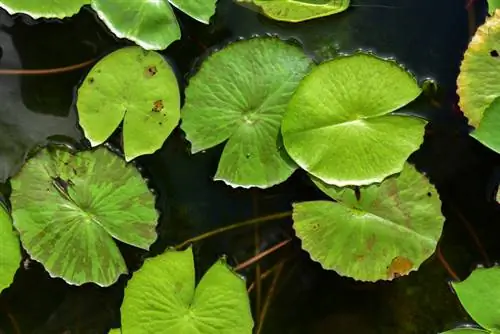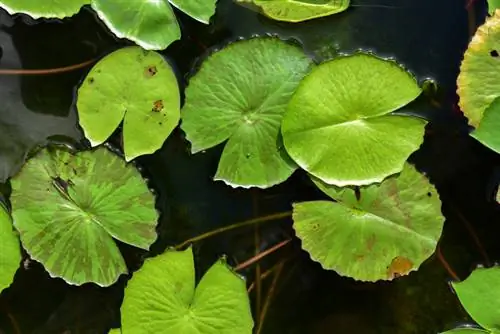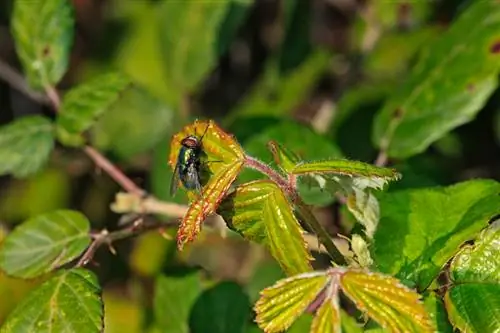- Author admin [email protected].
- Public 2023-12-16 16:46.
- Last modified 2025-06-01 06:02.
Not only pests such as the dreaded water lily leaf beetle, but also diseases can play havoc with water lilies, weakening them and encouraging them to die.

What diseases can affect water lilies and how can they be prevented?
Water lilies can be affected by leaf spot, tuber blight and stem rot. Optimal site conditions and removing infected plant parts are helpful as prevention. Research disease-resistant varieties before choosing a water lily.
Fungal diseases have an easy time
In general, water lilies - especially those in ponds - are considered sensitive to fungal pathogens. The reason is that their location preference provides an ideal breeding ground for fungi. Water lilies grow in moist to wet substrates. Mushrooms love such an environment and can spread quickly and unhindered.
Identifying leaf spot disease
All too often it is leaf spot diseases that plague water lilies. There are two pathogens that are occurring more frequently and making it difficult for the water lilies to continue living. You can recognize an infestation by this:
- dot-like discoloration of the leaves
- Dots are getting darker
- then holes appear
- then the leaves die off
If the plant is not treated, it will soon die. You should remove and dispose of affected parts as quickly as possible. As a prevention, it is important to minimize contributing factors. These include, for example, locations that are too shady and water that is too cold.
Blight - rhizome was attacked
Another dangerous disease is tuber blight. Here the rhizome is attacked first. As a rule, this disease does not appear until the water lily's second year of life at the earliest. Help is often not in sight. It is better to remove the diseased plant from the pond before the fungal spores spread to other water lilies or other plants in the pond.
You can recognize tuber rot on the water lily because the rhizome is brown to black. It stinks and the smell is reminiscent of rot. The rhizome is also soft. The leaves are also unusually colored. At first their color changes from dark green to light green. Finally they only describe a yellow color and are partly rolled up.
Stem rot - stems rot away
A third disease that can occur is stem rot. Here in brief:
- can be behind flower failure
- Stems have rotted
- Leaves turn light green to yellow
- Initial stage: cut away affected parts and dust interfaces with ash
- advanced stage: remove sick plant
Tip
Before you decide on a specific type and variety of water lilies, you should find out about their disease resistance!






